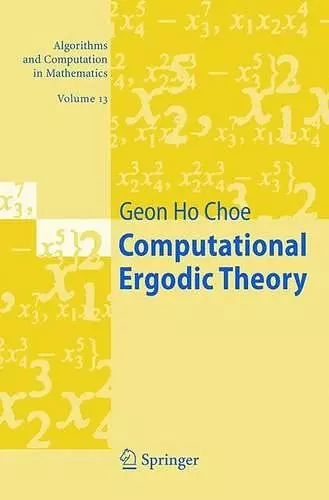Computational Ergodic Theory
Format:Hardback
Publisher:Springer-Verlag Berlin and Heidelberg GmbH & Co. KG
Published:11th Feb '05
Should be back in stock very soon

Ergodic theory is hard to study because it is based on measure theory, which is a technically difficult subject to master for ordinary students, especially for physics majors. Many of the examples are introduced from a different perspective than in other books and theoretical ideas can be gradually absorbed while doing computer experiments. Theoretically less prepared students can appreciate the deep theorems by doing various simulations. The computer experiments are simple but they have close ties with theoretical implications. Even the researchers in the field can benefit by checking their conjectures, which might have been regarded as unrealistic to be programmed easily, against numerical output using some of the ideas in the book. One last remark: The last chapter explains the relation between entropy and data compression, which belongs to information theory and not to ergodic theory. It will help students to gain an understanding of the digital technology that has shaped the modern information society.
From the reviews:
"When I first read the title of this book I thought it would be about a subfield of ergodic theory, but it is not. It is an introduction to ergodic theory that utilizes computer experiments to illustrate the basic ideas and examples of the subject. Given the historical roots of ergodic theory, this approach seems entirely appropriate. […]
The book is designed so that the Maple experiments are an integral part of the book. The author includes actual Maple programs. There are numerical simulations, symbolic computations and graphics programs. The subjects covered in the book are chosen so that the Maple experimetns can give insight into the examples and theorems. Most of the basic ideas and examples of ergodic theory are covered and all have Maple programs to illustrate them. Some more advanced topics are also covered, including homeomorphisms of the circle, Lyapunov exponents, Hausdorff dimension and data compression. It provides a mathematical introduction to ergodic theory coupled with a hands-on experimental approach. It is a well thought-out book and illustrates very well how computer experiments can shed light on many aspects of ergodic theory."
Bruce Kitchens, Bulletin of the American Mathematical Society, Vol. 44, Number 1, Jan. 2007
"[…] Summarizing, I think this is a very interesting book to consider for an introductory course about dynamical systems. Figures produced by well chosen simulations will help the teacher explain abstract concepts, while students’ curiosity will surely be stimulated by the possibility of performing experiments themselves, by modifying the programs presented in the book (which are also downloadable from the author’s personal webpage)."
Stefano Galatolo, Mathematical Reviews Clippings from Issue 2005m
"What can a computer tell us about ergodic theory? Well, the answer is quite a lot, as this recent volume testifies.Before opening my review copy I had anticipated (hoped for?) a comprehensive survey of algorithms for computing objects of interest in ergodic theory - ... Instead, this book is really a unique dynamical systems text, in which the key ideas of measurable dynamics are presented in a way that renders them intelligible to the uninitiated reader. .....Computational ergodic theory is a very good book for the right audience: those who want to learn about ergodic aspects of dynamics, but lack a strong background in analysis. ..."
Rua Murray, University of Waterloo, New Zealand Mathematical Society Newsletter No. 96
"This substantial book contains a basic course in ergodic theory and related ideas … . In particular the results presented here are developed rigorously and often proved … . The novel feature is that essentially all the results are illustrated with well-chosen examples and attractive pictures and graphs. … this book is highly recommended. It does a uniquely good job of explaining what the statements in ergodic theory mean numerically when applied to simple examples."
Thomas Ward, Zentralblatt MATH, Vol. 1064, 2005
"A computational approach, as advocated by the book under review, can help to make ergodic theory appealing to a wide range of science students by providing some hands-on experience. … Overall, with its mixture of theoretical and experimental parts, Computational Ergodic Theory constitutes an interesting addition to the textbook literature on the subject. The expert reader will no doubt find several less widely known examples together with ideas for future courses on dynamical systems." (A. Berger, Zeitschrift für Angewandte Mathematik und Mechanik, Vol. 86 (9), 2006)
ISBN: 9783540231219
Dimensions: unknown
Weight: unknown
453 pages